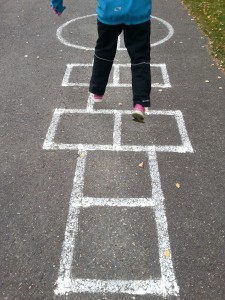 The evidence is crystal clear: Physical activity is great for kids. Researchers around the world agree that youth who are active have better brain function, higher self-esteem, more motivation and better school performance.
The evidence is crystal clear: Physical activity is great for kids. Researchers around the world agree that youth who are active have better brain function, higher self-esteem, more motivation and better school performance.
As a mother of three young kids, I can attest to the difficulty of getting them moving every day, especially as the days get shorter and the weather grows colder. So I was really excited when our elementary school launched a walking and running program. Essentially, kids head out to the school track a few times a week to log some laps. There’s also the chance to walk or run before school. As kids add up the miles, they win prizes, which they display as badges of honor.
Yesterday, my kids came home with t-shirts as proof they had each covered the distance of a half-marathon since the start of the school year. Their excitement got me thinking, how do physical activity programs help kids? Sure, my youngsters are proud of their new gear, but are there any broader effects?
In fact, there is a solid body of evidence that physical activity during the school day benefits students in a variety of areas.
For starters, two separate systematic reviews show that when teachers take classroom time for physical activity, kids are more likely to reach the recommended one -hour a day of physical activity. (Research published in the American Journal of Preventive Medicin) finds there are two other ways that best help kids to get enough exercise each day: mandatory physical education and active commuting to school. )
During the school day, kids don’t need to exercise for long periods of time. A review of studies published in 2011 found short bursts of physical activity – 10 minutes or less – increased kids’ attention in the classroom. Another 2011 review found kids who took short breaks for physical activity also performed better in school and displayed lower stress levels and better moods.
What about linking physical activity with teaching? A review published in 2015 found that when kids learn while moving their bodies, they perform significantly better on standardized tests. There are all sorts of examples of how to make this happen, such as doing jumping jacks while reciting spelling words, or playing “math hopscotch.”
The take-home message is clear: When kids are physically active throughout the day, they are healthier – both physically and psychologically – and they perform better in school.
As a parent, there are lots of little steps you can take to make sure your kids are getting enough exercise.
If possible, encourage your kids to walk or ride their bikes to school. And go along with them. You’ll benefit from the exercise too.
Contact your school’s leadership to inquire about a school-wide physical activity program. These types of programs are often spearheaded by parent-teacher organizations, and they are a great way to make a difference in your community.
Don’t underestimate the importance of using small blocks of time to help your kids become active. Do you have a few minutes before you need to leave for school in the morning? Jump rope in the driveway, or race your kids around the block. The evidence really does show that small bursts of activity are beneficial.



Speak Your Mind